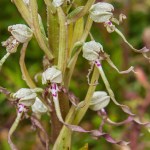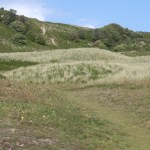The soils of the Island are predominantly acid, but in the west and south-east of the Island where blown sand has accumulated since the quaternary, extensive areas of calcareous dunes have formed. Sand dunes in Jersey are now a rare habitat and those at Les Blanches Banques make up the largest dune system in the Island.
Les Blanches Banques
 Sand dunes are a unique habitat due in part to the important flora and fauna they contain and are very sensitive and highly threatened habitats throughout Europe. In Jersey, there is a long standing recognition of St Ouen’s Bay as being a ‘special place’, as it is the only large open area of coastal dune remaining in the Island. The dunes on Les Blanches Banques have more than 400 flowering plant species including numerous Red Data Book species, ten orchids and some special rarities. The remaining dunes are protected by an SSI (Site of Special (Ecological) Interest) designation, but as development spreads right to the boundaries of the designated area, the edge effects will undoubtedly cause further damage to this unique area.
Sand dunes are a unique habitat due in part to the important flora and fauna they contain and are very sensitive and highly threatened habitats throughout Europe. In Jersey, there is a long standing recognition of St Ouen’s Bay as being a ‘special place’, as it is the only large open area of coastal dune remaining in the Island. The dunes on Les Blanches Banques have more than 400 flowering plant species including numerous Red Data Book species, ten orchids and some special rarities. The remaining dunes are protected by an SSI (Site of Special (Ecological) Interest) designation, but as development spreads right to the boundaries of the designated area, the edge effects will undoubtedly cause further damage to this unique area.
 The dune plain system (the lower seaward area) of Les Blanches Banques overlies Neolitic peat, which suggests that the dunes have formed over the last 2000 years. The dunes of the high plateau are thought to be considerably older.
The dune plain system (the lower seaward area) of Les Blanches Banques overlies Neolitic peat, which suggests that the dunes have formed over the last 2000 years. The dunes of the high plateau are thought to be considerably older.
Sand dunes are typically mobile, coastal habitats, with sand and salt being blown over the area by the prevailing wind and storms. This results in a unique flora, with only specialised plant species adapted to these extreme conditions of exposure, drought and salt being able to grow here. Since the construction of the sea wall, however, Les Blanches Banques has become a ‘closed’ sand dune system, with little sand being blown over the site. This has led to the dunes becoming stabilised, and has allowed different vegetation to grow and establish on the site. The area now has to be managed and monitored, to ensure that the dune vegetation is not lost completely.
There are a variety of habitats within the Les Blanches Banques dune system, including:
- a salt marsh area behind the sea wall
- bare sand
- marram grass dominated foredunes
- established short turf grassland
- rough grassland
- scrub areas
- small woodlands
- seasonal ponds
Each provides areas for many different plants and animals to establish.
 For British naturalists the position of the Channel Islands is equivocal; should they be treated as part of Britain or as part of France? Biogeographically they are related to France but as they separated from mainland Europe at about the same time as the British Isles, there is a case for treating them as an offshore island of Europe and part of the British Isles. They are interesting, not only in their own right, but also for the way they relate to the British Isles and to mainland Europe. They hold clues to the way species spread, colonise and survive, and to the way species distribution and abundance may change with climatic warming.
For British naturalists the position of the Channel Islands is equivocal; should they be treated as part of Britain or as part of France? Biogeographically they are related to France but as they separated from mainland Europe at about the same time as the British Isles, there is a case for treating them as an offshore island of Europe and part of the British Isles. They are interesting, not only in their own right, but also for the way they relate to the British Isles and to mainland Europe. They hold clues to the way species spread, colonise and survive, and to the way species distribution and abundance may change with climatic warming.
 Some of the long-term monitoring undertaken in Jersey may well provide invaluable data for examining climatic warming, whilst the floristic and zoological information is set against both the wider British and European context as far as possible. Some of the recording is based on invaluable ground work carried out by Jersey naturalists. Sufficient information now exists to show that the major features of Les Blanches Banques are the botanical and invertebrate biodiversities. A total of over 400 plant species has been recorded on Les Blanches Banques. Impressively, 55% of the species typical of dune habitats in the whole of the British Isles are represented at this one site and this figure
Some of the long-term monitoring undertaken in Jersey may well provide invaluable data for examining climatic warming, whilst the floristic and zoological information is set against both the wider British and European context as far as possible. Some of the recording is based on invaluable ground work carried out by Jersey naturalists. Sufficient information now exists to show that the major features of Les Blanches Banques are the botanical and invertebrate biodiversities. A total of over 400 plant species has been recorded on Les Blanches Banques. Impressively, 55% of the species typical of dune habitats in the whole of the British Isles are represented at this one site and this figure  is nearer 70% if those species only found in the south-west of England are considered. Jersey’s biogeographical location and the importance of the dunes are reflected in the 17 vascular plant species which are listed in the British Red Data Book and which occur on the dune system, among them the lizard orchid Himantoglossum hircinum, sand crocus Romulea columnae, small hare’s-ear Bupleurum baldense and childing pink Petrorlzagia naneuilii.
is nearer 70% if those species only found in the south-west of England are considered. Jersey’s biogeographical location and the importance of the dunes are reflected in the 17 vascular plant species which are listed in the British Red Data Book and which occur on the dune system, among them the lizard orchid Himantoglossum hircinum, sand crocus Romulea columnae, small hare’s-ear Bupleurum baldense and childing pink Petrorlzagia naneuilii.
As far as the invertebrates are concerned, the yellow and grey dunes support the most characteristic species, and many are typical of stressed, low productivity grasslands. The species-rich dune grass lands support the highest invertebrate diversity. There are many more rare invertebrates than plants, as might be expected, with, so far, 29 British RDB species, a further 26 which do not occur or are now extinct in Britain, and an additional 63 Nationally Scarce species. One IUCN RDB species, a wood ant Formica pratensis, now extinct in Britain, is among these species.
Flora
Marram grass Ammophila arenaria is one of the most common plant species at Les Blanches Banques. It flourishes in the calcium-rich environment of the sand dunes, and also plays a major part in forming them. Its tough spikey foliage acts as a barrier to wind blown sand, causing it to accumulate around the base of the plant, with the rhizomes (roots) of the plant helping to bind and stabilise the sand.
 The flora of this site is exceptionally diverse and includes the very rare:
The flora of this site is exceptionally diverse and includes the very rare:
- Nottingham catchfly Silene nutans
- Purple viper’s bugloss Echium plantagineum
- Sea-stock Matthiola sinuata
- Dwarf pansy Viola kitaibeliana
- Green winged orchid Anacamptis morio
- Early purple orchid Orchis mascula
- Lizard orchid Himantoglossum hircinum
Fauna
Les Blanches Banques is an important area for:
- Common toad Bufo bufo
 Green lizard Lacerta bilineata
Green lizard Lacerta bilineata- Grass snake Natrix natrix
- Sand martin Riparia riparia
- Wheatear Oenanthe oenanthe
- Skylark Alauda arvensis
- Common stonechat Saxicola rubecula
- Bank vole Clethrionomys glareolus
- Wood mouse Apodemus sylvaticus
- Millet’s or crowned shrew Sorex coronatus
- Lesser white-toothed shrew Crocidura suaveolens
- Rabbit Oryctolagus cuniculus
Rabbits are important to the site as they provide a natural management system by grazing, which in turn provides the right conditions for the smaller plants that would otherwise be overwhelmed.
Rare invertebrates such as the blue winged grasshopper Oedipoda caerulescens and bloody-nosed beetle Timarcha tenebricosa can be found here, as well as many butterflies which can often be seen in abundance on a hot summer day.
Site management
 Current management of the site includes the control of erosion and the loss of sand from this now stable dune system. The erection of fencing to catch sand and rebuild worn areas is a successful method. However, dune systems are inherently fragile and are very easily damaged by intensive human activities.
Current management of the site includes the control of erosion and the loss of sand from this now stable dune system. The erection of fencing to catch sand and rebuild worn areas is a successful method. However, dune systems are inherently fragile and are very easily damaged by intensive human activities.
The careful management of access helps to ensure the protection of this unique site, without undue restraint on its enjoyment by the public. Habitat condition is further improved by controlling the spread of scrub and the influx of potentially invasive species which may become dominant to the detriment of other native species. Holm oak Quercus ilex, is controlled through selective felling and coppicing. Ragwort Jacobaea vulgaris is controlled as it is classified as a noxious weed under Jersey law; however, total clearance does not take place as it is the primary food source for the caterpillar of the cinnabar moth Tyria jacobaeae.
Frequent patrols of Les Blanches Banques are undertaken by the warden of the site to collect litter, check for damage and monitor developments in the flora and fauna of the site.



